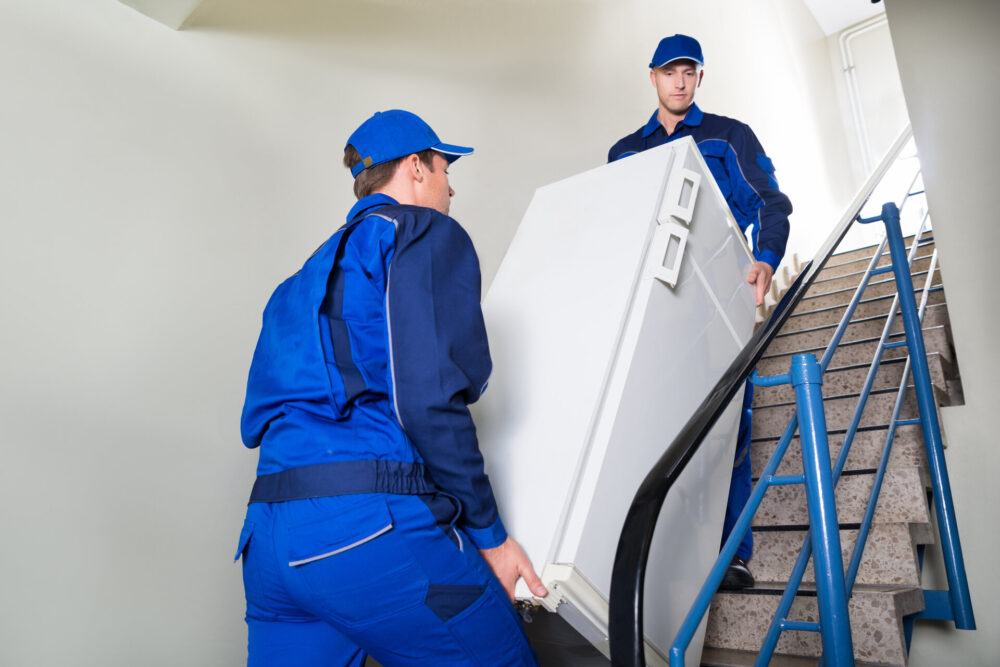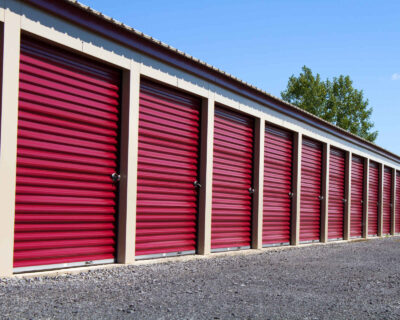A Complete Guide: How to Move a Refrigerator Safely and Efficiently
Transporting large and heavy items during a relocation can be a complicated task, but with the right knowledge and preparation, it can be accomplished safely and efficiently. Whether you’re relocating to a new home or simply rearranging your kitchen, this complete guide on how to move a refrigerator is here to help you navigate the process.

Relocating a fridge can be a complex task, but with proper planning and precautions, it can be done smoothly. It’s important to measure the refrigerator and new location, gather necessary supplies, and empty and defrost it beforehand. Secure and protect it using straps, blankets, and proper lifting techniques. When it arrives at the new location, position it correctly and allow it to stabilize before plugging it in. Hiring professional movers can simplify the process.
Moving a Refrigerator Starts With the Preparation
Before you begin the process, it’s crucial to dedicate some time to thorough preparation. This will help ensure a smooth and efficient relocation without any unnecessary complications. One of the first steps in the preparation stage is to measure both the refrigerator and the new location where it will be placed.
By doing so, you can determine whether it will fit through doorways, hallways, and other narrow spaces. This step is especially important if you’re relocating to a new home or rearranging your kitchen, as it allows you to plan the logistics and avoid potential obstacles and relocation mistakes along the way.
Measure the Refrigerator and the New Location to Ensure a Proper Fit
Measuring the dimensions of your appliance and the new location is a vital part of the preparation process. Start by measuring the height, width, and depth, taking into account any protruding handles or additional features. Next, measure the doorways, hallways, and any other passages it needs to go through.
It’s essential to ensure that there’s enough space for the fridge to pass without getting stuck or causing damage to the surroundings. By taking accurate measurements, you can identify any potential issues in advance and make necessary adjustments, such as removing doors or disassembling parts if required.
Gather Necessary Supplies and Equipment
For a fridge to be moved safely and efficiently, it’s essential to gather all the essential supplies and equipment, such as different packing materials, beforehand. Some of the essential items and packing materials you’ll need include relocation blankets, packing tape, a dolly or hand truck, bungee cords or straps, and protective gloves. The blankets provide cushioning and protection during transit while packing tape secures the doors and any loose parts.
A dolly or hand truck helps in maneuvering the fridge, and bungee cords or straps keep it securely in place during transportation. Additionally, wearing protective gloves will give you a better grip and protect your hands from any sharp edges, helping you avoid injury during relocation.
Empty the Contents of the Refrigerator and Defrost It Ahead of Time
Before transport, it’s crucial to empty the fridge and defrost it ahead of time. Start by consuming or discarding any perishable items, and then remove all the shelves, drawers, and detachable parts. Pack these separately and label them for easy reassembly later.
Defrosting the appliance is important to prevent water leakage during transport. Turn off the power and unplug it at least 24 hours in advance to allow the ice to melt and the interior to fully dry. Remember to place towels or absorbent materials around the exterior to catch any water that may drip during the defrosting process.
Once the appliance is completely defrosted and dry, wipe down the interior to remove any moisture and ensure cleanliness before transportation. Watch this video if you’d like more advice on how to defrost your fridge properly.
Secure and Protect the Refrigerator
Ensuring the safety of your appliance during the relocation process is paramount to prevent any damage or mishaps. Here are some essential tips on how to pack a refrigerator for shipping. First and foremost, unplug it from the power source to avoid any electrical hazards.
Next, secure any loose parts, shelves, and drawers by either taping them in place or removing and packing them separately. This prevents them from shifting or getting damaged during transit.
Additionally, it’s important to use straps or ropes to secure the doors tightly. This will prevent them from swinging open during transportation and causing potential damage. Finally, wrap the entire fridge in relocation blankets or bubble wrap to provide a protective layer and prevent scratches or dents. Secure the wrapping with tape to keep it in place.

How to Move a Refrigerator – A Step-by-Step Guide
Relocating appliances requires careful handling and proper techniques to ensure a safe and successful relocation. Follow this step-by-step guide on how to move your fridge with ease:
- Enlist the help of at least two strong individuals to assist with lifting and maneuvering, as this is a two-person job.
- Use a dolly or a hand truck for transport. Secure it onto the dolly or hand truck and carefully maneuver it, paying close attention to stairs, narrow passages, and tight spaces. Take your time and proceed cautiously to avoid any accidents.
- Use proper lifting techniques to avoid injury and strain. When lifting the appliance, remember to bend your knees, keep your back straight, and lift with your legs. Avoid twisting your body and ask your helper to lift from the other side simultaneously. This technique will reduce the risk of injury and strain on your back.
- Position it upright in the relocation truck to prevent damage. Ensure that it remains upright throughout the transportation process. Tilting it or laying it on its side can cause damage to the internal components.
- Secure it in an upright position using straps or bungee cords to prevent any shifting during transit. Once the appliance is inside the truck, secure it using straps or bungee cords. This will keep it in place and prevent any movement or shifting during transportation. Make sure it’s tightly secured to avoid any potential damage.
- Place additional padding or blankets around the exterior to provide extra protection. This will help cushion it and protect against bumps and vibrations during the journey. Secure the padding in place using packing tape or bungee cords.
Hire Cross Country Movers if You Want to Avoid Doing the Heavy Lifting Yourself
Relocating can be physically demanding, especially when it involves relocating across long distances. If you prefer to avoid the heavy lifting and want a smoother relocation experience, hiring cross-country movers can be a wise decision.
That way, you won’t have to worry about how to move a refrigerator without a dolly or how to move a refrigerator upstairs. A professional long-distance moving company specializes in handling relocations and can provide a range of long-distance moving services to make your move easier and more convenient.
Storage Service
Knowing what kind of surprises cross country move may hold, we offer 30 day free storage for belongings at the origin state.
Read morePacking Services
Our moving teams are trained to pack your belongings in the most efficient manner possible.
Read moreMoving Services
Whether you are moving from New York to Los Angeles or from San Francisco to Chicago, we can help you.
Read moreLong Distance Movers Can Take On Many Relocation Related Tasks
When you hire long-distance movers, you can benefit from their expertise and comprehensive range of services. These professional movers are experienced in handling all aspects of a long-distance relocation, including the logistics, packing services, transportation, and unloading of your belongings. They have the necessary equipment, resources, and manpower to handle even the most complex tasks, such as auto transport if you choose a car shipping company.
One of the primary advantages of hiring cross-country movers is that they can take care of the heavy lifting for you, and they help minimize relocation stress. Relocating heavy and large items like appliances, furniture pieces, and boxes can be physically challenging and potentially risky. Professional movers have the training and experience to safely and efficiently handle these items, reducing the risk of damage to your belongings or injuries to yourself.
In addition to lifting and carrying your belongings, cross-country movers can also assist with packing. They can provide packing materials and efficiently pack your items, ensuring their safe transportation. With their knowledge and experience, they can expertly pack valuable and fragile items to minimize the risk of damage during transport.
With Professionals on Your Side, You’re Fully Covered
Furthermore, cross-country movers can handle the logistics of your relocation. They have the expertise to plan and organize the transportation of your belongings, ensuring that they are efficiently loaded onto the truck and safely transported to your new destination.
They are familiar with the regulations and requirements of long-distance moves, including any necessary permits or paperwork, which can simplify the process for you. By hiring cross-country movers, you can also benefit from their moving insurance coverage. Reputable and legitimate relocation companies provide insurance options to protect your belongings during the relocation.
You can check if a company is legitimate on sites like Better Business Bureau. This can offer you peace of mind, knowing that you won’t have to worry about relocation scams and that your items are financially protected in the event of any unforeseen incidents or damages.

When the Fridge Arrives, Instal It Properly
After relocating, when your fridge arrives at its new location, it’s crucial to take the necessary steps to install it properly. This will ensure that it functions optimally and remains in good condition. There are a couple of essential tasks to perform once your fridge reaches its destination.
Carefully position it in its designated spot in the new location. Take into consideration any measurements or markings you made earlier to ensure a proper fit. Make sure the floor is level and stable to provide a solid foundation for such a bulky item.
If needed, use shims or adjust the feet of the fridge to achieve stability. Proper positioning is crucial for the optimal functioning of the appliance, as it allows for proper airflow and prevents any strain on the compressor or other components.
Don’t Rush With Plugging It In
Once the refrigerator is in its designated spot, it’s essential to allow it to stabilize for a few hours before plugging it back in. During transportation, it may have experienced vibrations and movements, which can disturb the compressor oil. Allowing it to stabilize gives the oil a chance to settle back into its proper place.
This waiting period allows the appliance to reach its ideal operating temperature gradually and ensures that it operates efficiently and smoothly once it’s back in use. Be patient during this time and resist the temptation to rush the process.
By following these steps, you can ensure that your appliance is installed properly and ready to serve its purpose in the new location. Taking the time to position it correctly and allowing it to stabilize before plugging it back in will contribute to its optimal functioning and longevity, allowing you to enjoy a well-functioning refrigerator for years to come.
Moving a Fridge Doesn’t Have to Be Hard and Troublesome Experience
Relocating a refrigerator doesn’t have to be a hard and troublesome experience. With proper planning, preparation, and following the right techniques, you can safely and efficiently transport it to a new location.
However, enlisting the help of professionals or cross-country movers is the best way to move a refrigerator, as it can alleviate the burden of heavy lifting. So, contact us at Flat Price Moving and Auto Shipping company and allow our movers to take care of everything and provide you with a stress-free relocation experience.
FAQs (Frequently Asked Questions)
How Much Does It Cost to Move a Refrigerator?
The cost of relocating refrigerators can vary depending on various factors, such as the distance of the relocation, the size and weight of the appliance, the complexity of the relocation, and additional services required. It’s recommended to obtain quotes from professional movers to get an accurate estimate based on your specific needs and circumstances.
Can I Lay the Refrigerator on Its Side During Transportation?
It is generally not recommended to lay a fridge on its side during transportation. Transporting it on its side can potentially damage the compressor and other internal components.
If it is absolutely necessary to tilt the refrigerator, it should be done for a short duration and at a minimal angle. However, it’s best to consult the manufacturer’s guidelines or the user manual to determine the recommended transportation position for your specific model.
How Far in Advance Should I Defrost My Refrigerator Before Moving?
It is advisable to start defrosting at least 24 hours in advance of the relocation. This allows sufficient time for the ice to melt and the interior of the refrigerator to dry out completely. Defrosting in advance helps prevent water leakage during transportation and ensures that the appliance is clean and prepared for movers.
Is It Necessary to Hire Professional Movers for Moving a Refrigerator?
While it is not absolutely necessary to hire professional movers, it can greatly simplify and streamline the process and allow you not to worry about how to pack a refrigerator for moving.
Professional movers have the expertise, equipment, and experience to handle the heavy lifting, navigate tight spaces, and ensure the safe transportation of your refrigerator. They can also provide additional services such as packing, unpacking, and insurance coverage, which can offer convenience and peace of mind.
What Precautions Should I Take if I Need to Store the Refrigerator Temporarily?
If you need to store the fridge temporarily, there are a few precautions to keep in mind. First, thoroughly clean and dry the appliance before storing it to prevent mold or mildew growth. Leave the doors slightly ajar or use a prop to keep them open to allow for proper ventilation. It’s important to store it in a cool, dry place to avoid any damage from humidity. If possible, disconnect it from the power source and remove any perishable items or contents.
Can I Transport Perishable Food Items in the Refrigerator During the Move?
It is not advisable to transport perishable food items in the fridge during shipping, especially if the relocation involves a long distance or extended duration. Perishable items are prone to spoilage and can contaminate the interior of the appliance during transportation. It’s best to consume or discard perishable items before the relocation and restock your fridge with fresh items upon reaching the new location.
How Can I Safely Clean the Refrigerator Before and After the Move?
To safely clean the refrigerator before and after the relocation, first, you have to unplug it from the power source. Remove all shelves, drawers, and other detachable parts and wash them separately using warm and soapy water. Use a mild cleaning solution or a mixture of baking soda and water to clean the interior.
Pay special attention to any spills or stains. Rinse and dry all the parts thoroughly before reassembling them. Ensure that the appliance is completely dry before plugging it back in or before storing it.









